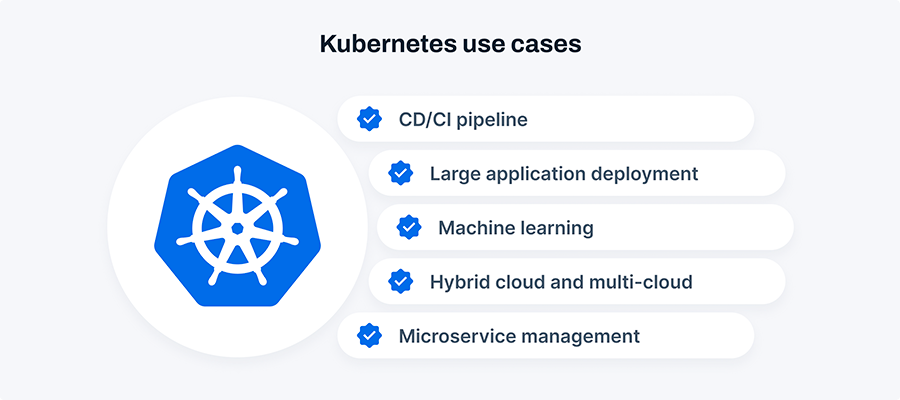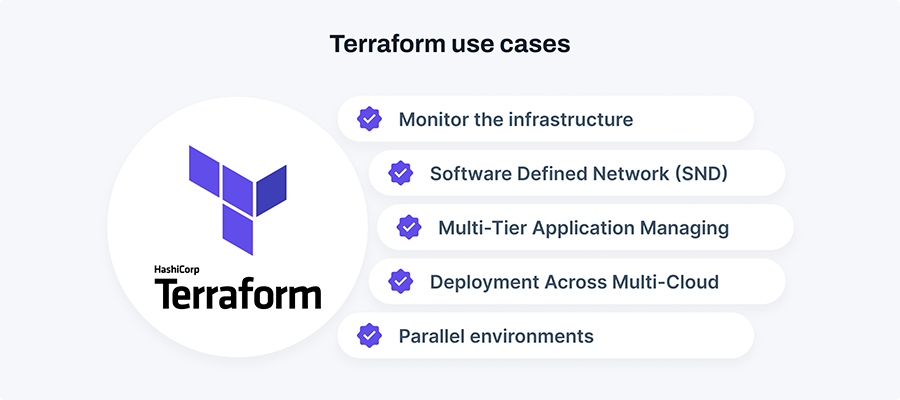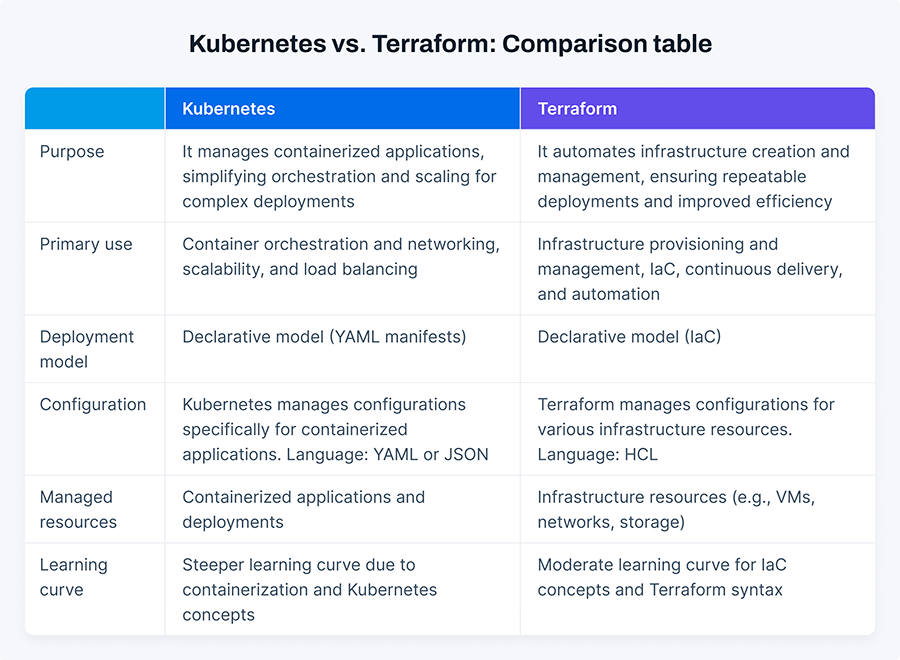Kubernetes vs. Terraform: Pros, Cons & Differences
March 01, 2024In modern cloud infrastructure management, Kubernetes and Terraform are two powerful DevOps tools, each offering distinct capabilities and functionalities. Kubernetes, created by Google, is an open-source platform that orchestrates containers, automating tasks like deploying, scaling, and managing containerized applications. Terraform, contrasting Kubernetes, functions as an infrastructure as code (IaC) tool, allowing users to specify and deploy cloud infrastructure resources through declarative configuration files.
While both Kubernetes and Terraform play crucial roles in cloud-native environments, understanding their differences and use cases is essential for organizations seeking to optimize their infrastructure management strategies.
This article delves into the key features, strengths, and use cases of Kubernetes and Terraform, providing insights into how they complement and differentiate from each other in the dynamic landscape of cloud computing and DevOps practices.
What is Kubernetes?
Kubernetes, a collaborative effort between Rancher Labs and Google, simplifies container management by enabling developers to automate software deployment across various environments. Its main features include self-recovery, load balancing, and auto-scaling, which provide developers with easy scaling options through command-based scaling.
Kubernetes often refers to K8s. This platform efficiently automates the deployment, scaling, and management of containerized applications, serving as a robust container orchestration solution. Originally developed by Google, it’s now maintained by the Cloud Native Computing Foundation (CNCF). Kubernetes has gained widespread adoption in the industry for its ability to streamline the deployment and management of complex microservice architectures.
Furthermore, Kubernetes provides a rich ecosystem of tools and resources, including a vast array of third-party plugins, extensions, and integrations. This ecosystem enables developers to extend Kubernetes’ functionality and customize it to meet their specific requirements, whether deploying stateful applications, managing storage, or implementing advanced networking features.
Kubernetes use cases

CI/CD development
Utilizing Kubernetes within a CI/CD (continuous integration and continuous delivery) pipeline ensures seamless integration and deployment of containerized applications. Its robust orchestration capabilities enable efficient management of continuous integration and delivery processes, facilitating streamlined workflows and rapid software delivery cycles.
Large applications deployment
Kubernetes excels at managing large containerized applications, providing essential features like horizontal pod scaling and load balancing. These capabilities enable efficient handling of hardware defects and sudden spikes in traffic, ensuring reliable performance and seamless scalability for even the most demanding applications.
Machine learning
Kubernetes optimizes machine learning model deployments by adjusting resource allocation to match the model’s needs. This strategy reduces downtime by updating deployments gradually and automating workflow tasks. Moreover, Kubernetes enhances the efficiency and adaptability of machine learning workflows by supporting execution in local and cloud environments.
Hybrid cloud and multi-cloud
An environment-agnostic approach addresses challenges associated with deploying applications across diverse environments, regardless of their operating systems and dependencies. Kubernetes flexibility enables seamless configuration and automation of workloads in hybrid and multi-cloud environments, streamlining management and ensuring consistency across platforms.
Additionally, Kubernetes' robust features facilitate efficient resource allocation and scaling, enhancing application performance and reliability in complex cloud ecosystems.
Microservice management
Kubernetes is well-suited for managing communication within applications employing microservice architecture. It provides features for controlling microservice behavior during failures, resource distribution, and simplifying authentication processes, enhancing application reliability and scalability.
Kubernetes: pros and cons
| Pros | Cons |
|---|---|
| Horizontal scaling | Requires time to learn |
| Container managing tool | Limited service coverage |
| No infrastructure lock-ins | Workflow adjustments are necessary to align with K8s |
| Ensures replicant’s healthiness and automotive healing | Only cloud infrastructure |
| Extensive documentation | Vendor lock-in makes migrating harder |
What is Terraform in DevOps?
Terraform offers robust automation capabilities for configuring software infrastructure securely and efficiently, making it versatile across different environments. Professionals can easily scale, modify, and adjust cloud environments to meet specific business needs using Terraform.
Terraform enhances the productivity of IT teams managing cloud infrastructure by facilitating code sharing, thereby expanding its functionality. Developed by HashiCorp, a US-based software company, Terraform enables developers to collaborate effectively on projects involving cloud computing infrastructure.
Terraform use cases

Deployment across multi-cloud
Multi-cloud deployments expand its reach, positioning it as a top choice across a range of cloud environments. HashiCorp configuration language (HCL) facilitates the management of cross-cloud dependencies and enables seamless deployment across multiple cloud platforms. This feature improves infrastructure reliability and resilience, ensuring stable performance and flexibility across cloud setups.
Moreover, Terraform’s support for multi-cloud deployment strategies empowers organizations to leverage the strengths of different cloud providers while minimizing vendor lock-in and optimizing resource allocation.
Software-defined network (SDN)
Integration with software-defined networking facilitates seamless communication, which streamlines ticket-based workflows and automates deployment processes. This capability drastically reduces deployment times, empowering organizations to achieve faster and more efficient infrastructure provisioning. By leveraging Terraform’s SDN integration, teams can dynamically configure and manage network resources, ensuring optimal performance and scalability for their cloud infrastructure.
Infrastructure monitoring
Terraform employs a state file to monitor the infrastructure, maintain a record of resources, and track changes. This file serves as a blueprint, enabling Terraform to analyze modifications and identify the necessary adjustments to align the infrastructure with the desired configuration. Additionally, the state file facilitates collaboration among team members, providing visibility into the current state of the infrastructure and ensuring consistency across deployments.
Multi-tier application management
Terraform simplifies the management of multi-tier applications by organizing interdependencies within each tier. Utilizing plugins and dependencies ensures consistency across tiers, guaranteeing precise installation and implementation with each deployment. This approach streamlines the process, even though manual installation may pose challenges.
Parallel environments
In software development, it's standard to set up various environments for different stages of the development process. With Terraform, developers can efficiently manage the infrastructure for each environment, making it easy to configure and maintain to simplify the process and reduce costs associated with environmental management.
Terraform: pros and cons
| Pros | Cons |
|---|---|
| Multi-cloud deployment | Doesn’t support GKE |
| Easy to record | It is challenging to manage state files separately |
| Prevents downtime | Can’t handle errors |
| Easily readable documentation | New releases can have bugs |
| Version control possibilities | Not for beginners |
What is the difference between Kubernetes and Terraform?
While many blogs may highlight similarities between these two modern technologies, it's important to recognize their distinct differences. Despite both being integral to modern infrastructure management, Terraform and Kubernetes serve different purposes and offer unique capabilities. Understanding these differences is essential for effectively leveraging each tool within your technology stack.
Focus
Kubernetes
Kubernetes is primarily focused on container orchestration and management. Kubernetes simplifies the management of containerized applications by handling deployment, scaling, and operations. It removes the need to worry about the underlying infrastructure, making managing tasks like networking, storage, and scheduling easier.
Kubernetes offers features such as automatic scaling, load balancing, service discovery, and self-healing capabilities, making it ideal for deploying and managing microservice-based applications. Its focus on container orchestration enables developers to build, deploy, and scale applications seamlessly across hybrid and multi-cloud environments.
Terraform
In contrast, Terraform is focused on infrastructure as code (IaC), enabling the provisioning and management of cloud infrastructure resources using declarative configuration files. Its primary focus is defining, provisioning, and managing infrastructure components such as virtual machines, storage, networking, and services across multiple cloud providers and on-premises environments.
Terraform abstracts away the complexities of infrastructure provisioning, allowing users to define infrastructure configurations using a domain-specific language (HCL). Its focus on infrastructure automation and management enables users to define and manage the entire infrastructure stack, from compute resources to networking and security policies.
Terraform’s flexibility and extensibility make it suitable for automating infrastructure deployments, defining complex infrastructure topologies, and managing infrastructure resources across various cloud environments.
Primary use
Kubernetes
The primary use of Kubernetes is to orchestrate and manage containerized applications at scale. It automates the deployment, scaling, and management of containerized workloads, providing container orchestration, service discovery, load balancing, and automated scaling features.
Terraform
The primary use of Terraform is to automate the provisioning, configuration, and management of infrastructure resources across various cloud providers and services. It enables users to define infrastructure as code using a declarative configuration language, allowing for consistent and reproducible infrastructure deployments.
Learning curve
Kubernetes
The learning curve for Kubernetes can vary depending on prior experience with containerization and cloud-native technologies. Kubernetes may have a steep learning curve due to its complex concepts and extensive feature set for beginners.
Newcomers to Kubernetes have the advantage of a wealth of resources, documentation, and tutorials tailored to help them understand the fundamentals and steadily improve their skills over time. With dedication and practice, individuals can overcome the initial challenges and become proficient in deploying and managing applications with Kubernetes.
Terraform
Terraform's learning curve is considered to be moderate. While it may initially require some time to understand its concepts and syntax, its declarative approach and comprehensive documentation make it relatively accessible for beginners. With practice and experimentation, users can quickly become proficient in using Terraform to manage infrastructure as code.
Terraform vs. Kubernetes: Which one should you choose?

Kubernetes vs. Terraform: Comparison table
| Terraform | Kubernetes | |
|---|---|---|
| Purpose | It automates infrastructure creation and management, ensuring repeatable deployments and improved efficiency | It manages containerized applications, simplifying orchestration and scaling for complex deployments |
| Primary use | Infrastructure provisioning and management, IaC, continuous delivery, and automation | Container orchestration and networking, scalability, and load balancing |
| Deployment model | Declarative model (IaC) | Declarative model (YAML manifests) |
| Configuration | Terraform manages configurations for various infrastructure resources. Language: HCL | Kubernetes manages configurations specifically for containerized applications. Language: YAML or JSON |
| Managed resources | Infrastructure resources (e.g., VMs, networks, storage) | Containerized applications and deployments |
| Learning curve | Moderate learning curve for IaC concepts and Terraform syntax | Steeper learning curve due to containerization and Kubernetes concepts |
Given its focus on infrastructure as code (IaC), Terraform is an ideal solution for organizations seeking to codify their application infrastructure. It is particularly beneficial for managing infrastructure across various public and private cloud environments.
Like Terraform, Kubernetes embraces the Infrastructure as Code (IaC) approach. Leveraging Kubernetes within an IaC framework proves advantageous for standardizing cluster configurations. It excels in projects aiming to optimize resource utilization through horizontal scaling.
Conclusion
In conclusion, Terraform and Kubernetes are powerful tools in the DevOps arsenal, each serving distinct purposes. While Terraform excels at automating infrastructure provisioning across various cloud platforms, Kubernetes shines at managing containerized applications and orchestrating their deployment and scaling. The choice between the two ultimately depends on the specific needs and objectives.
For organizations seeking infrastructure automation and management, Terraform may be the preferred option, whereas those focused on container orchestration and application deployment may find Kubernetes more suitable. Regardless of your choice, both tools offer valuable capabilities to streamline and enhance your DevOps workflows.
Are you struggling to choose which is most suitable for you? Let us know so experts from the Kaa team can find the best solution for your needs.
FAQ
Can you use Terraform with Kubernetes?
Terraform can provision and manage the infrastructure required for Kubernetes clusters. It complements Kubernetes by automating the setup of underlying resources like virtual machines, networks, and storage, facilitating a streamlined deployment process.
Should I learn Kubernetes or Terraform first?
It depends on your goals. If you’re focused on managing containerized applications, start with Kubernetes. For infrastructure provisioning and management, begin with Terraform.
Is Terraform an alternative to Kubernetes?
No, Terraform and Kubernetes serve different purposes. Terraform is for infrastructure provisioning, while Kubernetes is for container orchestration.
Can Terraform manage Kubernetes?
Yes, Terraform can manage Kubernetes by provisioning and configuring the underlying infrastructure on which Kubernetes clusters run, but it doesn't directly manage Kubernetes resources.
